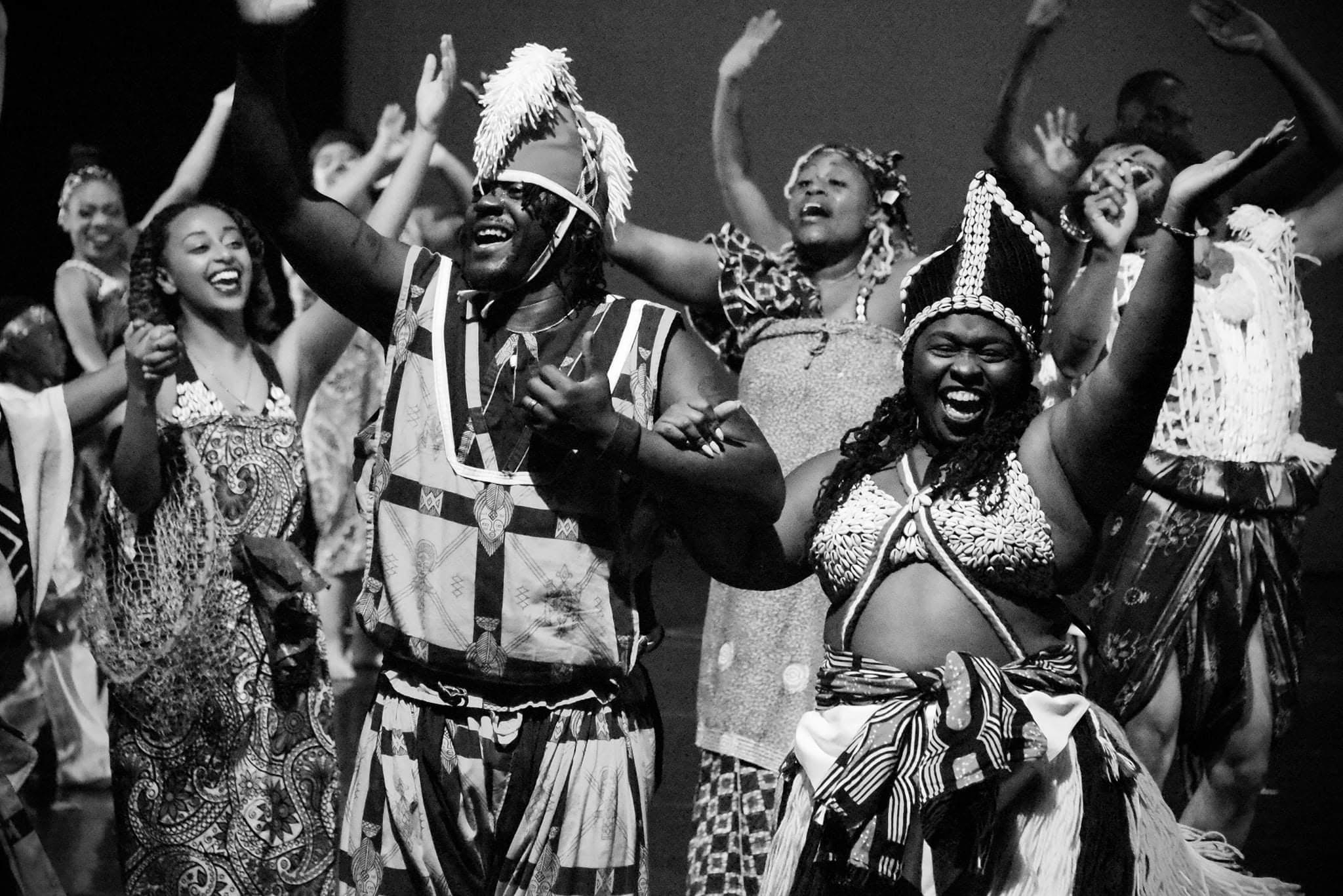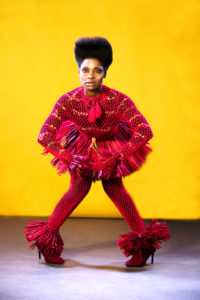
Photo by Cindy Manly-Fields
For 45 years Diamano Coura has used West African dance as a vehicle to further the preservation, education, and appreciation of traditional West African music, theater, and culture. Under the leadership of Director Dr. Zak Diouf and Artistic Direction of Naomi Diouf Diamano Coura has proven to be more than a dance company, but a community. Through ongoing workshops, performances, youth programs, community outreach, and creative partnership programs Diamona Coura has nurtured generations of Bay Area dancers. Diamano Coura Dance Company and their well trained dancers have brought West African dance and culture to audiences in Europe, Asia and the Americas. Diamona Coura has also participated in innovative collaborations with San Francisco and Singapore Ballets to combine classical African dance with European style ballet. Diamano Coura has served countless youth through its arts in education program. More important than their dance representation they are respected elders and role models for artists across various disciplines; including myself. I have witnessed the dynamic dance duo at cultural events and meetings authentically building bridges and connections with members of the Oakland community. As Diamano Coura celebrates its 45th anniversary, I interviewed founders Zak and Naomi. They openly shared what inspired their passion for dance, origins of the Diamano Coura name and their upcoming 25th annual Collage de la Cultures Africaines program.
Early influences
Zak discovered his passion for dance close to home in Senegal, while watching his mother’s older sister Coura Thiaw. He endearingly called her the “Grandmother of Senegalese dance.” She toured internationally and performed traditional West African dance. Zak describes the moment that ignited his passion for dance: “It was 1942 and she had returned from touring in Europe after WWI. Coura Thiaw stood at 5’3” but had a big presence. I watched her in amazement as she kicked her legs high in the air. That day, I committed to pursuing dance.” Naomi recalls a family event that featured traditional Liberian dancers performing Doglor. The Doglor is a war dance from the Grebo/Glebo people of Cape Palmas in the Southeastern Region of Liberia. “I was 6 years old and my family was hosting an event with many people. They begin with powerful drumming and then marching. They went through the yard and around the house. I watched in amazement and from that moment I knew I wanted to dance.”
Those who bring a message
Diamano Coura, means “those who bring the message” in Senegalese Wolof language. Intrigued by the meaning of Diamano Coura, I ask Naomi and Zak to share what was the original message they intended to share 45 years ago. Zak replies, “The message we wanted to popularize is the historical components of African dance and what it represents through the African lens. I see dance as a myth created thousands of years ago and an important resource in understanding Africa’s past and present. Dance is a history lesson! We also wanted to show that African culture is not monolithic but includes a wide range of diversity. Senegal is home to many ethnic groups and each has their own way of showing togetherness, strength, love and respect through dance. In my ethnic group, dance is a part of our religion. We dance for joy, for sorrow and to pass the time. Even Senegal’s first president encouraged and funded cultural artists to travel abroad. We were seen as Ambassadors that would make the world more understanding and diverse through traditional dance.” Naomi shared similar sentiments about the name and pointed out the historical context that shaped their message. “The 1970s was the time of the Black Arts and Black Power movement in the United States. The African Diaspora desired to change the narrative of Africa and develop a strong sense of identity. At the time African culture and dance was devalued and considered primitive. Despite the precise muscle articulation required to correctly execute the purpose and feelings the movement entailed. West African dance provided university students with the opportunity to connect to their African roots or engage with historical facts beyond lecture. Dance had a way of connecting to students in ways words alone could not. There is a historical component to West African dance that acknowledges the great civilizations and empires to whom these dances belong. At the time, students taking Zak’s West African dance classes at San Jose State University wanted to extend cultural literacy beyond the classroom. Dance was seen as an additional avenue to debunk myths about Africa and convey to audiences that West African dance was so much more than jumping around.”
Evolution of Diamano Coura message
Over the last couple of decades African dance and culture has gained more acknowledgement and appreciation globally. In almost every dance studio you will see some form of African dance being offered. The internet has also provided access to traditional and contemporary African dances to all interested in learning the various dance forms. I wondered: How has this global recognition and appreciation for African dance has changed Diamano Coura’s original message? When asked, Naomi acknowledged that the global reverence and interest in West African dance has exposed their original message to a wider audience. The exposure has also created more economic opportunities and creative collaborations for African dancers worldwide. Along with Naomi’s celebration of how far African dance has come she doesn’t shy away from the fact that African dance collectively is still fighting to shake the label of primitive dance: “Though African dance is popularized on an international level; from Germany to South America you see dancers incorporating elements of traditional and popular African dance. However, when it comes to analyzing or critiquing African dance techniques, there is still more work to do.” Naomi went on to explain, “Even the media struggles to do a proper critique of African dance or doesn’t provide one at all, compared to other dance forms. It is no fault of anyone, many lack the language, vocabulary or knowledge needed to provide a dance critique. It is hard to critique or describe what you don’t understand.”
Collage de la Cultures Africaines

Photo courtesy of artist
Before wrapping up the interview we discussed another major milestone of Diamano Coura, 25 years of the Collage de la Cultures Africaines program. Collage is a four-day conference featuring master classes in music, dance and live performances by renowned Bay Area dance companies, which also offers local merchandise and food for purchase. Every year, Collage showcases the Bay Area’s diverse, innovative and multigenerational Black dance movement, in the heart of Oakland. This year’s festivities will be hosted at Laney College. Zak describes Collage as an opportunity for dancers of all backgrounds to learn about the diversity of African dance with world renowned instructors. “It is also a homecoming! We have trained five generations of dancers and they often return with their grandchildren or great grandchildren.” Naomi also joins in on Zak’s excitement of the upcoming Collage de la Cultures Africaines program: “Collage is always an exciting gathering of old friends and bringing in new ones. At Collage you will see political discourse, civic questions explored and history through dance performances and workshops. It is an intergenerational event and open to all cultures interested in learning about the evolution of African dance and techniques found in all current dance.
We have two new groups, Afro Urban Society and a soloist from the Ivory Coast. Afro Urban Society pays homage to traditional African dance while incorporating contemporary dance from the African diaspora. We also will feature Soloist Fely Tchaco from the Ivory Coast performing Zaouli Dance. The Zaouli Dance is a masked dance that is traditionally performed by a man but will be performed by a woman. Additionally, returning after many years representing Tahiti dance group Halau Ka Ua Tuahine will grace the stage. Every year we attempt to break boundaries at Collage de la Cultures Africaines and welcome dancers of all backgrounds and levels to join in the festivities.”
This article appeared in the March 2020 issue of In Dance.

